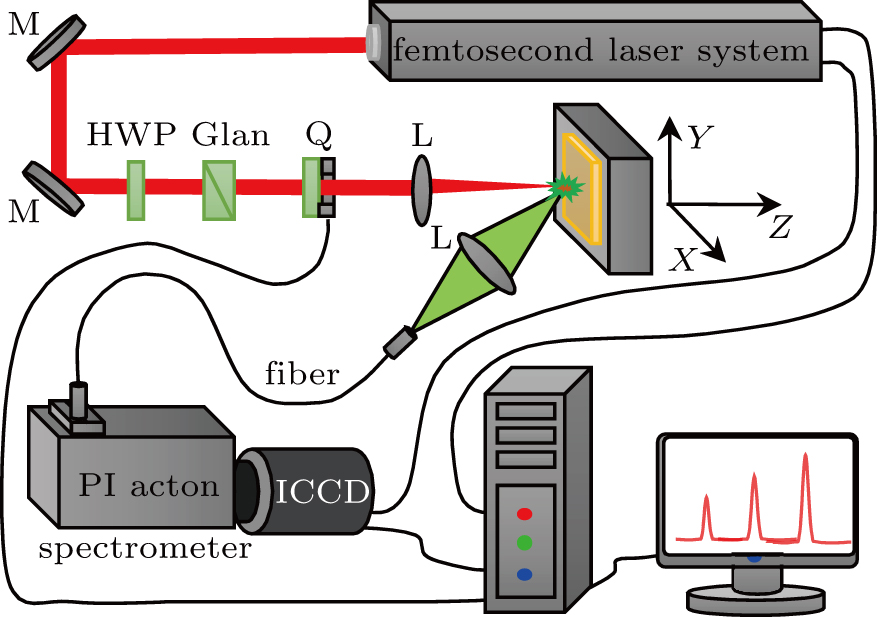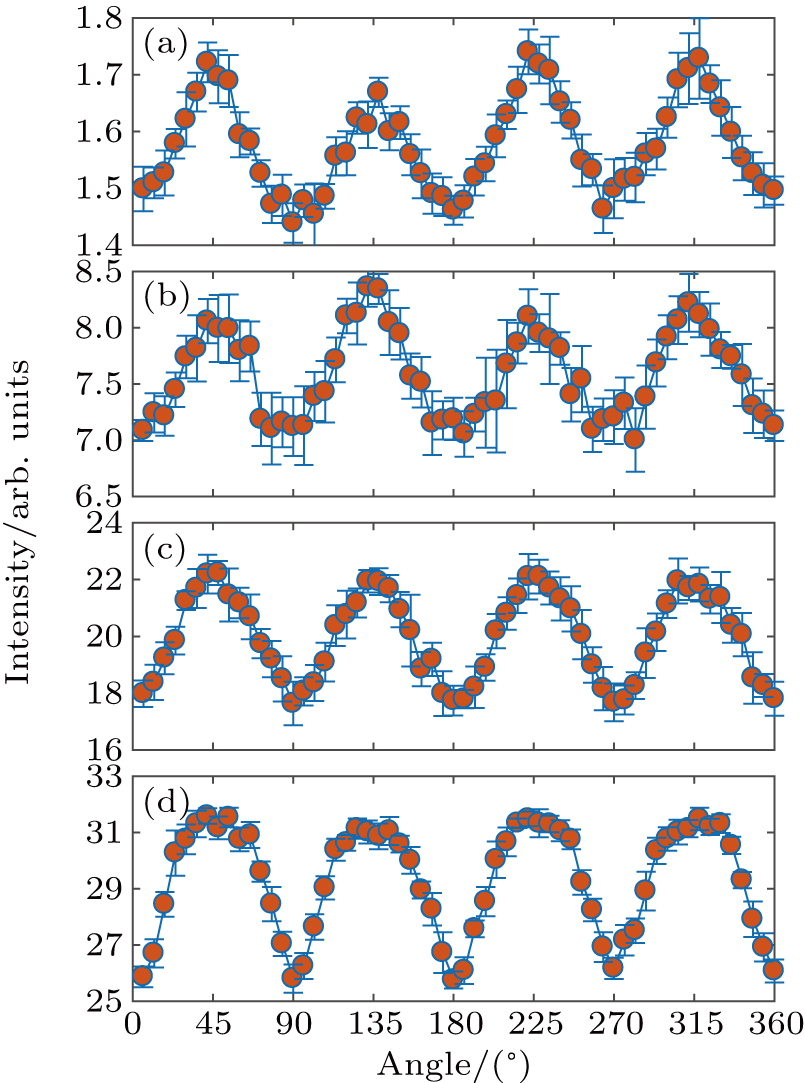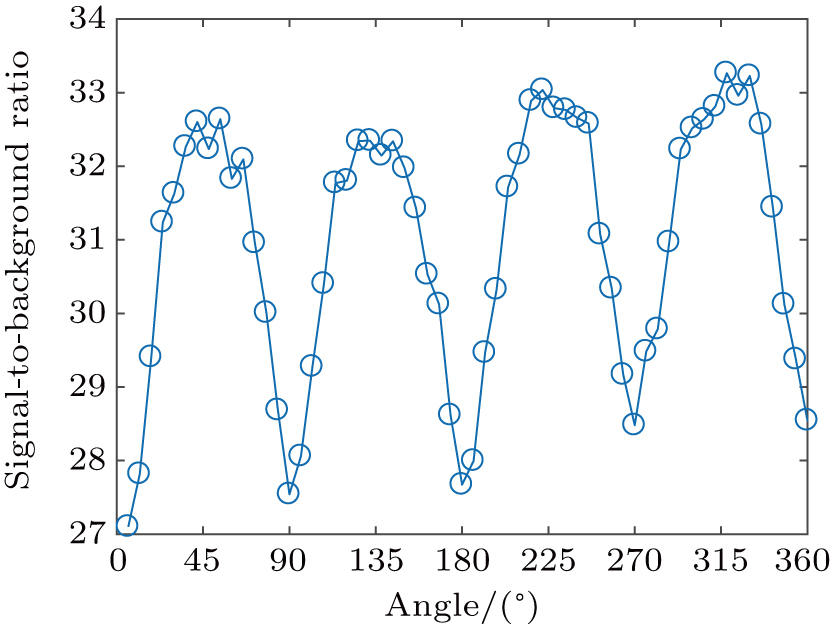† Corresponding author. E-mail:
Project supported by the National Natural Science Foundation of China (Grant Nos. 11674128, 11674124, and 11974138), the Jilin Provincial Scientific and Technological Development Program, China (Grant No. 20170101063JC), and the Scientific and Technological Research Project of the Education Department of Jilin Province, China (Grant No. JJKH20200937KJ).
Laser-induced breakdown spectroscopy (LIBS) is an important technique which is widely used to analyze element composition. In order to improve the sensitivity of LIBS, much effort has been made to enhance the spectral intensity of LIBS by proposing a number of methods. In addition, we find that laser polarization has great influence on the emission intensity of femtosecond LIBS. By comparing the emission intensity of femtosecond LIBS in the circular polarization with that in the linear polarization, the spectral intensity in the case of circular polarization is stronger than that in the case of linear polarization. Moreover, this phenomenon is more obvious as laser energy increases. The polarization plays an important role in LIBS signal intensity. Based on the observation, the enhanced mechanism of the laser polarization for the spectral intensity is discussed in this paper, which will be helpful in spectral analysis and component analysis.
Laser-induced breakdown spectroscopy (LIBS) is an effective technique to analyze the component of material without any preparation of sample.[1–5] The principle of this method is as follows. A high-energy laser beam is focused onto the target surface to produce plasma, and then plasma creates the emission spectrum: this emission spectrum is used to analyze the element composition.[6–9] In recent years, the LIBS has achieved dramatic development and received much attention due to its practical applications such as in environmental monitoring, biological agents, and aerosol testing. More importantly, the high efficacy, non-intrusiveness, and real-time analysis make it extensively employed for detecting the sample composition. Although the LIBS has been successful in numerous applications, its sensitivity, accuracy, and precision are still poor compared with those of other analytical techniques.[10] Through improving the spectral intensity, the sensitivity can be greatly enhanced since the analysis process is easier and clear. In the past decades, many people have proposed some techniques to improve the spectral emission intensity, such as double-pulse excitation,[10–15] electromagnetic field,[16–20] spatially confined LIBS,[21–25] nanoparticle-enhanced LIBS,[26,27] femtosecond pulse excitation,[28,29] spark-assisted LIBS,[30–33] and increasing sample temperatures.[34–38] In addition, changing the polarization state of laser pulse may also be an effective and feasible method, which can be easily achieved by using a quarter-wave plate.
The phenomenon that the spatial distribution of the electric vector vibration of light wave loses symmetry in the direction of light propagation is called the polarization of light, and only the shear wave can produce polarization. Any light whose vibration loses this symmetry is collectively called polarized light. The polarization states can be divided into three types: the circular one, the linear one, and the elliptical one. The polarization characteristics of laser pulses can be changed by rotating 1/4 wave plates: circularly polarized laser is produced when the rotation angle of 1/4 wave plates is 45° + n × 90°, and linearly polarized laser is created when the rotation angle is n× 90°. Polarization state of laser pulse can affect the spectral intensity through influencing the electron density and plasma temperature, which are the most important characteristics of plasma.[39] We experimentally demonstrated that circularly polarized laser pulses can produce the spectra with higher emission intensity than the linear laser pulses. In addition, the width of laser pulse also acts as an essential feature in investigating the effect of laser polarization.[40]
With the fast development of laser technology, femtosecond pulse laser can output higher laser energy. The femtosecond pulse laser is accompanied with a higher intensity, hence there is a significant benefit in using ultra-short pulse laser: its output power is high enough to be applied to many fields.[41–46] The ultra-short laser pulses have been used for examining and processing the materials in the past decades,[47–49] and they can improve the ablation repetition rate and reduce the sample pollution. More importantly, the ablated hole size is small, enhancing the control of micro-fabrication process, when comparing with the scenario of the nanosecond pulse or longer pulse.[50–54] Utilizing the advantages mentioned above, femtosecond laser as an excitation source is introduced for improving the sensitivity of the LIBS. Femtosecond laser with ultra-fast and ultra-intense characteristics can rapidly inject all energy into the sample based on its very short pulse width. As a result, the spectral emission produced by femtosecond LIBS has some advantages including a low continuous spectrum, allowing the spectral signals with many laser shots to accumulate.[28] However, the reduced interaction between excitation light source and produced plasma causes emission intensity to lower.
Referring to different laser polarization effects on LIBS, femtosecond laser is introduced into LIBS. Comparing with optical emission induced by the linearly polarized laser, and changing the polarization of laser pulse into elliptical and circular cases, the emission intensity of LIBS may be obviously improved. Recent investigations of electron momentum distribution after the tunnel has been ionized by femtosecond laser indicate that the partitioning of energy for circular polarization is different from that for linear polarization. For instance, Mitryukovskiy et al. studied that the optical emission from neutral and singly ionized N2 molecules created by femtosecond laser filamentation in atmospheric environment depends strongly on femtosecond laser polarization,[55] and their results illustrated that the femtosecond laser polarization states influence the plasma through affecting the kinetic energy of electrons. Lemos et al. observed that the expansion of the plasma plume created by circularly polarized laser is quicker, which indicates that the electron temperature is increased by more than 50%.[56] Wang et al. demonstrated that circularly polarized femtosecond laser can improve emission intensity of LIBS.[57] The polarization can play an important role in femtosecond LIBS signal intensity.[57] However, the physical reason of the influence of polarization state on the spectral intensity is less investigated and still is an open question. Therefore, we investigate the influence of the polarization on the spectral emission intensity in detail.
In this paper, we discuss the influence of the polarization of laser pulse on spectral intensity by comparing the breakdown spectra of Cu, produced by different polarized laser pulses. The spectral intensity values produced by femtosecond laser pulses under different polarization states are investigated, thereby trying to figure out the physical pattern of effects caused by polarization. Meanwhile, we also calculate the plasma temperature and electron density under different polarization states, which are both essential characteristics of plasma and can conduce to explaining the mechanism of this phenomenon.
Figure
Figure
In femtosecond laser ablation of metal, the absorption mechanism is the mechanism for inverse bremsstrahlung absorption.[58] Femtosecond laser ablation of metal is a non-equilibrium process.[45] During femtosecond laser irradiation, free electrons in the metal absorb laser energy, and electron temperature increases rapidly (relative to lattice heat capacity, electron heat capacity is very low).[59,60] Compared with the change in the electron temperature, the change in the lattice temperature is negligible. With the increase of delay time, electrons transfer energy to the lattice through electron-lattice coupling mechanism and then the lattice temperature begins to increase (while the electron temperature begins to decrease), so that the lattice begins to melt, evaporates, and forms plasma. In addition, the kinetic energy of free electrons for the circular laser polarization is higher than that for linear laser polarization.[61,62] After the circularly polarized femtosecond laser irradiates the copper target, the energy of the free electrons in the target will be higher than that obtained under the linearly polarized laser. Therefore, the energy of the electrons transferred to the lattice will be relatively high. The circular polarized laser will produce a higher temperature and density plasma, resulting in a stronger spectral emission.
The mechanism of how the polarization state of laser pulse affects the plasma spectrum has been debated for several years. Previous experimental studies found some differences between plasmas produced by light with different polarization states. For example, Lemos et al. demonstrated experimentally that the expanded velocity of plasma plume produced by femtosecond laser with circular polarization is faster than that with linear polarization.[56] It is known that the femtosecond laser pulses can excite the plasma under the ionization mechanism, which is called “above threshold ionization (ATI)”. The velocity of ionized electrons is determined by the phase of laser electric field at the moment of ionization. When electrons are ionized into free electrons, the energy acquired by electrons is related to the phase of electric field. Corkum et al. pointed out that the electron temperature of an under-dense plasma could be controlled through changing the polarization and wavelength of the ionizing laser pulse.[3] They also calculated the electron energy spectra, respectively, for circularly and linearly polarized laser-induced plasma, discovering that the spectral energy for circularly polarized laser is higher and therefore gives rise to a higher plasma temperature which in turn accelerates the plasma expansion. Arissian et al. investigated the kinetic energy of electrons of plasma created by the circularly and linearly polarized laser pulses with circular and linear polarizations.[40] According to their results, the electron momentum distribution measured after tunnel has been ionized with short pulses, and the associated THz radiation show that the distribution of energy produced by the circularly polarized laser is different from that by the linearly polarized laser. Circularly polarized light leads to higher kinetic energy.[63,64] Therefore, the collisions between electrons and Cu atoms are more frequent in circular polarization condition, creating the denser plasma. To verify the above discussion, we measure the distribution of spectral intensity of Cu plasma, which is excited by laser pulses with different polarizations for different laser energ values (see Fig.
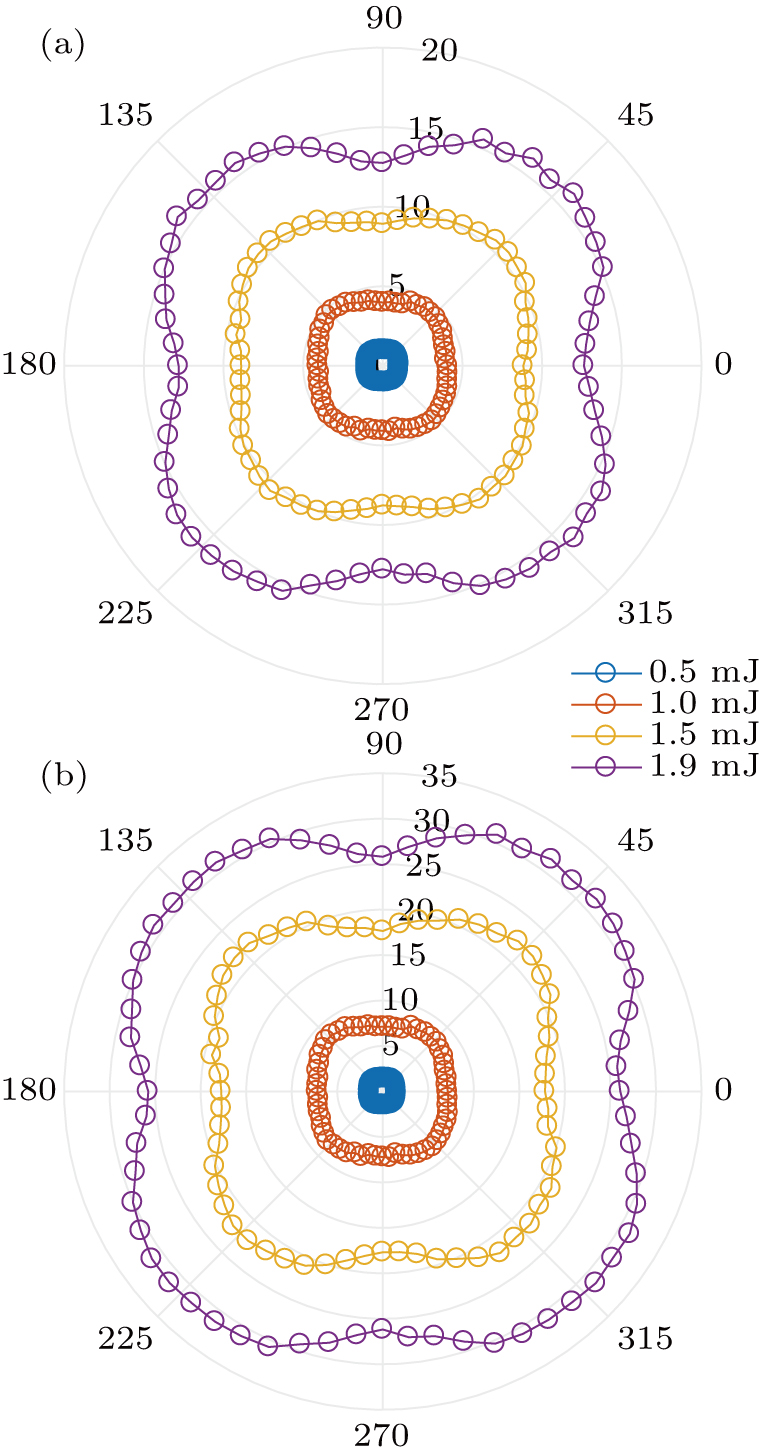 | Fig. 3. Variation of Cu (I) lines at (a) 510.55 nm and (b) 521.82 nm with angle of quarter-wave plate for different laser energy. |
To further discuss the effect of laser polarization on the spectral emission, we present the variation of Cu (I) line at 521.82 nm with the rotation angle of quarter-wave plate for different laser energy values as shown in Fig.
The question is how the polarization states affect the kinetic energy of electrons. According to the Mitryukovskiy et al.’s study,[55] for linearly polarized laser pulses, free electrons possess low kinetic energy because they are alternately accelerated and decelerated by laser electric fields in each optical cycle of the pulses. By comparison, electrons are continuously accelerated under the action of circularly polarized pulses, which enables the electrons to collide with more Cu atoms, and increases the emission intensity of breakdown spectrum. To be more specific, a large number of electrons with a kinetic energy of about 2Up are first generated at the end of laser pulse (
From the above discussion, the electron kinetic energy is influenced by the polarization of light since circularly and linearly polarized laser pulses are subjected to different acceleration and deceleration processes, and the acceleration process can enhance the energy of the charged particles. The fundamental reason of this phenomenon still needs exploring. Bashmakov et al. provided us with guidance in quantum electrodynamical cascades.[65] They investigated the effect of laser polarization on quantum electrodynamical cascading in a standing electromagnetic wave through numerical simulation, indicating that the cascade dynamics is obviously more complicated in the laser field in the case of linearly polarized laser since the electrodynamical field is divided into two qualitatively different parts: the “electric” regions (where the electric field is stronger than the magnetic field) and the “magnetic” regions (where the magnetic field is stronger than the electric field). In the “magnetic” regions, acceleration is an obstacle, while the high-energy electrons are cooled down through emitting photons. On contrary, acceleration is steady in the “electric” region. The volumes of “magnetic” and “electric” region evolve periodically in the case of linearly polarized laser while the volum remains invariable over time in the case of circularly polarized laser. It is noted that acceleration increases the probability of quantum electrodynamical cascading process significantly by turning around the particles transversely to the field and the cascade rate is increased accordingly. Therefore, the number of cascade particles in the case of circularly polarized laser undergoes an exponentially increase while the number of particles in the case of linearly polarized laser grow in time stair-step-like on a logarithmic scale. The energy spectra of electrons under linearly polarized laser pulses show a moderate increase in the particle number accompanied by plasma heating under the action of “electric field”, and it peaks when the whole space is covered by the “electric” region, and become minimal as the “electric” field is replaced completely by the “magnetic” field. Therefore, it can be concluded that the different physics processes of “electric” region and “magnetic” region lead to different acceleration and deceleration processes, which causes electron kinetic energy to be higher (in the case of circularly polarized laser) or lower (in the case of linearly polarized laser) and eventually affects the collisions of electrons with Cu atoms.
As mentioned in the above theory, the energy of free electrons produced by the circularly polarized laser pulse is higher than that by the linearly polarized light, which in turn causes more collisions and thus heats the plasma. We attempt to obtain the plasma temperature and electron density for supporting our propositions. We assum that the laser-induced plasma is in local thermodynamic equilibrium and optically thin, the plasma temperature is calculated by the Boltzmann plot method through using the integrated intensity of the emission line emission of copper plasma: ln(λI / gkAki) = –Ek / kBTe + C,[66,67] where λ is the wavelength, I the line intensity, k the upper level, i the lower level, gk the degeneracy of the upper level, Aki the transition probability, Ek the energy, kB the Boltzmann constant, Te the plasma temperature, and C the constant. In order to obtain the plasma temperature, the Cu (I) 510.55-nm, 515.32-nm, and 521.82-nm lines are selected and used to calculate the plasma temperature. This is because the three spectral lines have all a wide upper level energy range, which can highly improve the accuracy of the experimental result.[68] Relevant parameters are obtained from previously published papers.[45,69] The numerical value of ln(λI/gA) is calculated to estimate the plasma temperature. The obtained data and Ek are plotted, and then the slope of function -(1/kBTe) is obtained by fitting the coordinates of linear points. The typical linear fitting diagram is presented in Fig.
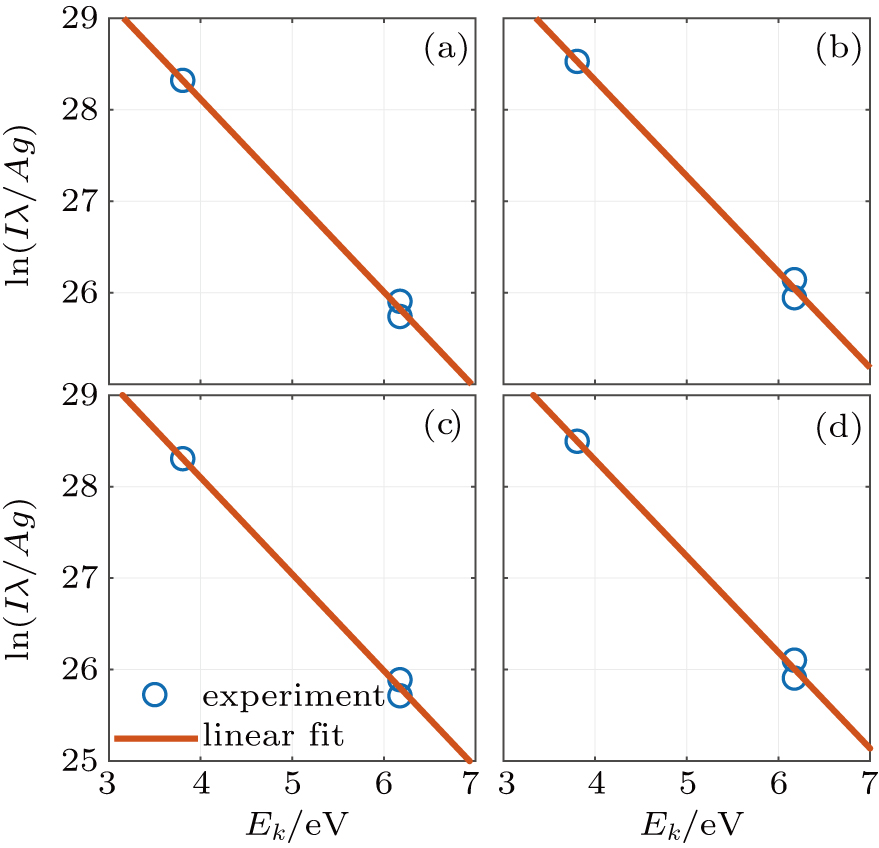 | Fig. 5. Typical Boltzmann plots for selected angles with laser energy being 1.9 mJ. The angles are (a) 0°, (b) 45°, (c) 90°, and (d) 135°. |
Now consider the electron density. Here, the electron density is calculated by the FWHM of the emission line and Stark broadening: Δλ1/2 = 2ω (Ne / 1016), where Δλ1/2 is the FWHM of emission line, ω the electron collision coefficient, and Ne the electron density. In addition, the line broadening includes natural broadening (ΔλN), Doppler broadening (ΔλD), instrument broadening (Δλinst), Δλ1/2 = Δλobs –ΔλN – ΔλD – Δλinst, with Δλobs being the observed line width in the experiment. In laser-induced plasma, the natural broadening and Doppler broadening are very small compared with the Stark broadening and can be ignored. The line width Δλ1/2 = Δλobs – Δλinst. The observed line width is about 0.04 nm, which is determined by measuring the width of Hg lines emitted from a mercury lamp under low pressure. We use Cu (I) 521.82-nm line to calculate the electron density. The typical Lorentz fitting curves for the observed line width (Δλobs) at different angles of 1/4 wave plate (0, 45, 90, and 135) is shown in Fig.
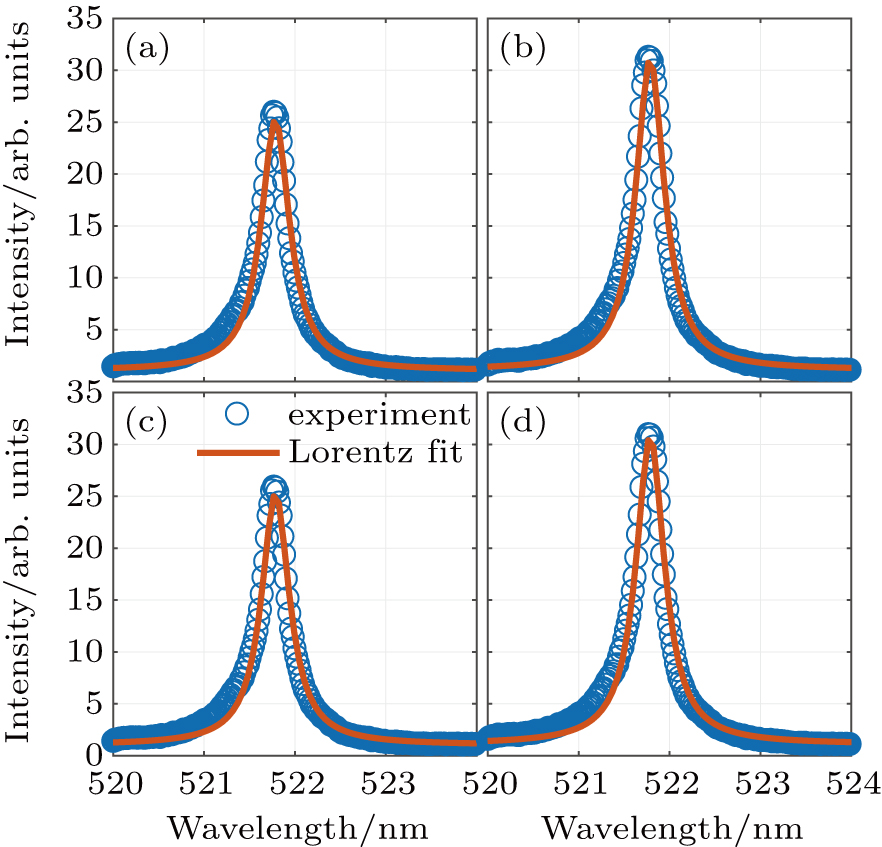 | Fig. 6. Typical Lorentz fitting for selected angles with laser energy being 1.9 mJ and angle being (a) 0°, (b) 45°, (c) 90°, and (d) 135°. |
Figure
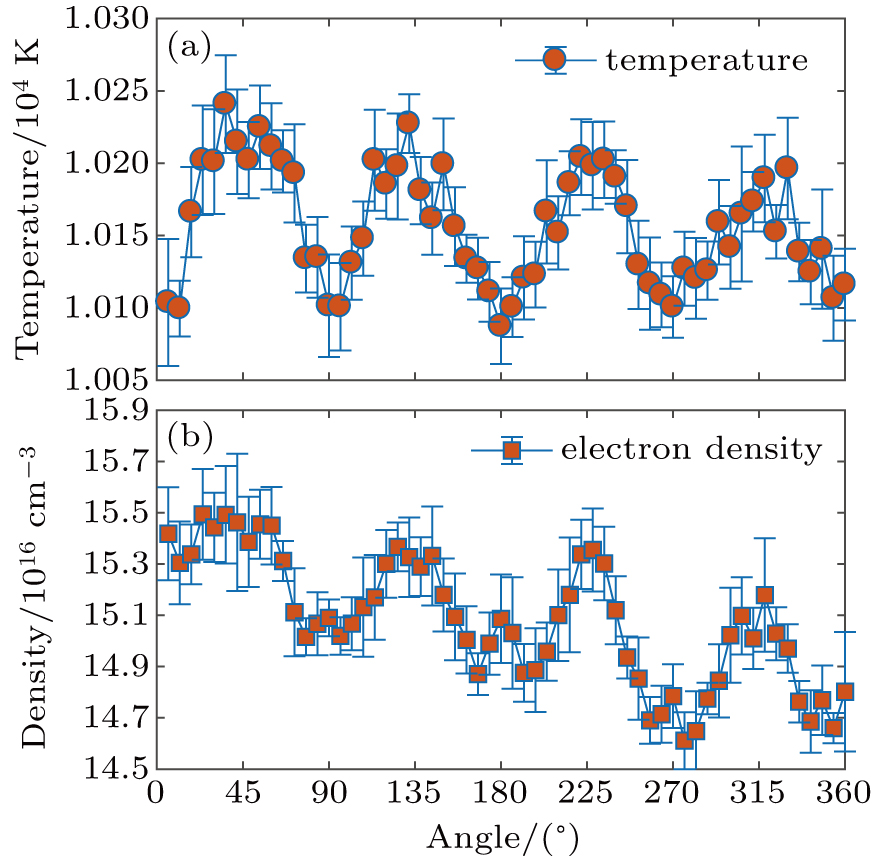 | Fig. 7. Evolution of (a) plasma temperature and (b) electron density with angle of quarter-wave plate, with laser energy being 1.9 mJ. |
In this work, we demonstrate that the spectral line intensity of femtosecond laser-induced Cu breakdown spectrum strongly depends on laser polarization. The circularly polarized femtosecond laser leads to higher spectral intensity than the linearly polarized femtosecond laser due to the presence of electrons with high kinetic energy created by the circularly polarized laser pulse. The evolutions of two regions (the “electric” one and the “magnetic” one) are different, which gives rise to different acceleration and deceleration mechanism which can account for the difference in electron motion. Those electrons with higher kinetic energy are more likely to collide with Cu atoms and produce higher temperature plasma, causing higher emission intensity. We believe that these findings are conducive to understanding the mechanism of femtosecond LIBS and improving the sensitivity of this technique.
| [1] | |
| [2] | |
| [3] | |
| [4] | |
| [5] | |
| [6] | |
| [7] | |
| [8] | |
| [9] | |
| [10] | |
| [11] | |
| [12] | |
| [13] | |
| [14] | |
| [15] | |
| [16] | |
| [17] | |
| [18] | |
| [19] | |
| [20] | |
| [21] | |
| [22] | |
| [23] | |
| [24] | |
| [25] | |
| [26] | |
| [27] | |
| [28] | |
| [29] | |
| [30] | |
| [31] | |
| [32] | |
| [33] | |
| [34] | |
| [35] | |
| [36] | |
| [37] | |
| [38] | |
| [39] | |
| [40] | |
| [41] | |
| [42] | |
| [43] | |
| [44] | |
| [45] | |
| [46] | |
| [47] | |
| [48] | |
| [49] | |
| [50] | |
| [51] | |
| [52] | |
| [53] | |
| [54] | |
| [55] | |
| [56] | |
| [57] | |
| [58] | |
| [59] | |
| [60] | |
| [61] | |
| [62] | |
| [63] | |
| [64] | |
| [65] | |
| [66] | |
| [67] | |
| [68] | |
| [69] |


